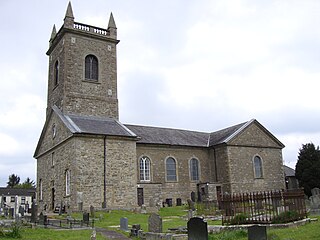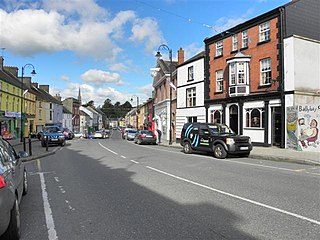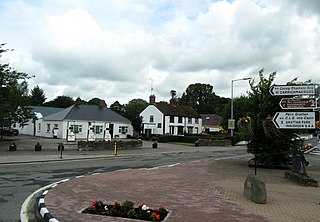Related Research Articles

Catherine Parr was Queen of England and Ireland as the last of the six wives of King Henry VIII from their marriage on 12 July 1543 until Henry's death on 28 January 1547. Catherine was the final queen consort of the House of Tudor, and outlived Henry by a year and eight months. With four husbands, she is the most-married English queen. She was the first woman to publish in print an original work under her own name in England in the English language.

County Monaghan is a county in Ireland. It is in the province of Ulster and is part of Border strategic planning area of the Northern and Western Region. It is named after the town of Monaghan. Monaghan County Council is the local authority for the county. The population of the county was 65,288 according to the 2022 census.

Clones is a small town in the west of County Monaghan in Ireland. The area is part of the Border Region in the Republic of Ireland, earmarked for economic development by the Irish Government due to its currently below-average economic situation. The town was badly hit economically by the Partition of Ireland in 1921 because of its location on the border with County Fermanagh in Northern Ireland. The creation of the Irish border deprived it of access to a large part of its economic hinterland for many years. The town had a population of 1,680 at the 2016 census. The town is in a civil parish of the same name.

Carrickmacross is a town in County Monaghan, Ireland. The town and environs had a population of 5,032 according to the 2016 census, making it the second-largest town in the county. Carrickmacross is a market town which developed around a castle built by the Earl of Essex in 1630. The town is 20 km west of Dundalk and 75 km north-north-west of Dublin city centre and 106 km south west of Belfast. Carrickmacross won the European Entente Florale Silver Medal Award in 1998. The local Gaelic football and hurling club is Carrickmacross Emmets. The local soccer team is Carrick Rovers.

The Bishop of Clogher is an episcopal title which takes its name after the village of Clogher in County Tyrone, Northern Ireland. Following the Reformation, there are now parallel apostolic successions: one of the Church of Ireland and the other of the Roman Catholic Church.

Carrickmacross lace is a form of lace that may be described as decorated net. A three-layer 'sandwich' is made consisting of the pattern, covered with, first, machine-made net and then fine muslin, through which the pattern can be seen. A thick outlining thread is stitched down along the lines of the pattern, sewing net and fabric together. Loops of thread known as 'twirls' are also couched along the outer edge. The excess fabric is then cut away. Some of the net is then usually decorated further with needle-run stitches or small button-holed rings known as 'pops'. Occasionally bars of buttonhole stitches are worked over fabric and net before both are cut away.
Monica Barnes was an Irish Fine Gael politician who served as a Teachta Dála (TD) for the Dún Laoghaire constituency from 1982 to 1992 and 1997 to 2002. She was a Senator for the Labour Panel from February 1982 to November 1982 and a Member of the Council of State from 1991 to 1995. She was a feminist and women's right activist who co-founded the Council for the Status of Women.

Ballybay is a town and civil parish in County Monaghan, Ireland. The town is centred on the crossroads of the R183 and R162 regional roads.

Tydavnet, officially Tedavnet , is a village in northern County Monaghan, Ireland, and also the name of the townland and civil parish in which the village sits. Both the Church of Ireland and Catholic church have Tydavnet named as a parish and in both cases, the geographical area is almost identical. The village is located on the R186 regional road.
Patrick Mulligan was the Roman Catholic Bishop of Clogher in Ireland from 18 January 1970 until 7 July 1979, when he was succeeded by Joseph Duffy.

Inniskeen, officially Inishkeen, is a small village, townland and parish in County Monaghan, Ireland, close to the County Louth and County Armagh borders. The village is located about 17 kilometres (11 mi) from Dundalk, 11 km (7 mi) from Carrickmacross, and 5 km (3 mi) from Crossmaglen. Seven townlands of this Roman Catholic Diocese of Clogher parish lie within County Louth.

Charles Bingham, 1st Earl of Lucan, known as Sir Charles Bingham, 7th Baronet, from 1750 until 1776, was an Irish peer and politician.

George Montgomery (1562–1621) was a Scottish protestant cleric, promoted by King James VI and I to various Irish bishoprics. He held the offices of Rector of Chedzoy, Somerset; Dean of Norwich (1603); Bishop of Raphoe, Bishop of Clogher, Bishop of Derry (1605); and Bishop of Meath (1610).

Irish lace has always been an important part of the Irish needlework tradition. Both needlepoint and bobbin laces were made in Ireland before the middle of the eighteenth century, but never, apparently, on a commercial scale. It was promoted by Irish aristocrats such as Lady Arabella Denny, the famous philanthropist, who used social and political connections to support the new industry and promote the sale of Irish lace abroad. Lady Denny, working in connection with the Dublin Society, introduced lace-making into the Dublin workhouses, especially among the children there. It is thought that it was an early form of Crochet, imitating the appearance of Venetian Gros Point lace.

"Something old" is the first line of a traditional rhyme that details what a bride should wear at her wedding for good luck:
Belle Isle Castle is an 18th-century house on Belle Isle, an island previously known, in Gaelic times, as Ballymacmanus Island or Senadh-Mic-Maghnusa or, simply, Senad. The Belle Isle Estate stretches over 470-acres near Lisbellaw in County Fermanagh, Northern Ireland.
John Porter was an 18th-century Anglican bishop in Ireland.
Lawrence "Larry" Duffy is an Irish Roman Catholic prelate who has served as Bishop of Clogher since 2019.

Vincent Peter Martin is an Irish Green Party politician who has served as a Senator since June 2020, after being nominated by the Taoiseach.

Cherry Crawford Hyndman (1768-1845) was the mistress of a liberal political household in Belfast, Ireland, and reputedly in the 1790s an active member of the republican Society of United Irishmen.
References
- 1 2 3 4 Lunney, Linde (2009). "Porter, Margaret Lavinia)". In McGuire, James; Quinn, James (eds.). Dictionary of Irish Biography. Cambridge: Cambridge University Press.
- ↑ "Carrickmacross". Guild of Irish Lacemakers. 27 October 2014. Retrieved 3 August 2018.
- ↑ "Clare is keeping lace alive in Ashford - Independent.ie". Independent.ie. Retrieved 3 August 2018.
- ↑ "Carrickmacross Lace Gallery - Monaghan Tourism". monaghantourism.com. Retrieved 3 August 2018.
- ↑ "Carrickmacross Lace - The Lace Gallery". The Lace Gallery. Retrieved 3 August 2018.
- ↑ "Carrickmacross | The Little Lace Museum". thelittlelacemuseum.wordpress.com. Retrieved 3 August 2018.